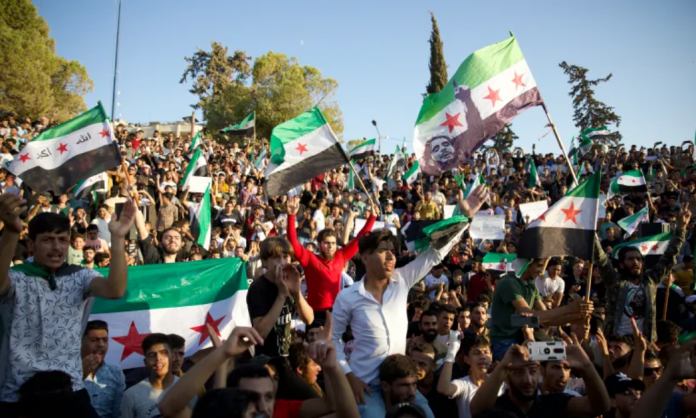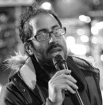Large demonstrations have been taking place across Syria in recent weeks. While their scale has yet to reach the peaks seen in 2011, many are hopeful that the government will be brought down. To get a more detailed assessment of the movement and the situation it faces in Syria, Red Flag spoke to long-time Syrian leftist Jamal Chamma. Jamal is based in Melbourne and has been involved for years in organising demonstrations in solidarity with the Syrian revolution.
--------------------
A chant has been echoing in the streets of Syria’s cities over the past month: “The people want the fall of the regime!”. This thrilling call for the downfall of the Assad family dynasty has been repeated by thousands of protesters angry at a government that has failed to meet their basic needs. The movement started in fits and bursts over summer, but was transformed after a general strike was launched in Suweida, a city in the country’s south-west, on 17 August. The movement quickly spread across the country, but it continues in that region, where crowds have been flocking to public places, singing and chanting as they burn posters of Assad’s face while proudly bearing the revolutionary flag.
The immediate trigger has been an economic crisis brought on by runaway inflation. The prices of bread, petrol and other essentials have increased dramatically in recent months, due to the collapse of the Syrian pound and withdrawal of government subsidies on bread and other essentials. The United Nations estimates that 90 percent of the country lives in poverty.
“One US dollar is now worth around 14,000 Syrian pounds on the street exchanges: it was 10,000 in June. Back in 2011, it was just 50 pounds”, Jamal explained. “In 2011 people used to receive around $200 a month as a salary or pension, now they get about ten bucks”, Jamal says.
Society is in total collapse and the population is once again in free fall: “People have been sending their kids away, selling their house to pay for a plane ticket to Europe or anywhere. There’s no future under Assad”.
For those who can’t leave, resistance is the only option. Hence the wave of protests and strikes that broke out over summer. Hundreds of volunteers distributed revolutionary leaflets across the country on 10 August. A general strike was called in Suweida on 17 August and again three days later. Roads and businesses were shut, university exams were deferred.
Their demands were initially focused on the economy: calling for salaries and pensions to be raised to $100 per month, for a ban on the privatisation of public assets and for the introduction of subsidies on electricity, bread, diesel and petrol. They also called for the release of political prisoners and an end to the regime’s open facilitation of the Captagon (an amphetamine-type drug) trade.
Jamal recalls how the politics of the movement evolved: “The first couple of days they didn’t ask the regime to fall, they just asked to live like a human being ... But every day, the chanting changed. Quickly, they began saying: ‘We want the regime to fall’”. This evolution of slogans, from the reforming to the revolutionary, is a familiar pattern in major social rebellions. But in Syria, it has a particular significance.
It was just over a decade ago when supporters of Syria’s unelected president infamously declared: “Assad or the country burns”. And burn it did. The Assad regime unleashed a brutal wave of violence and repression, using barrel bombs, murder and torture on an industrial scale, and even chemical weapons on the population.
The regime was supported by Russia and Iran, which used the crisis to deepen their influence and gain access to vital resources. But it was also assisted by the US and its allies, which refused to provide the necessary aid to allow the revolutionaries to overcome the government.
Jamal is furious that his country has become a political playground for the various powers: “Everyone uses Syria, nobody cares about Syria: the Russians, the Iranians, the Americans and the Arab League”.
The results speak for themselves. In 2021, the United Nations Human Rights Council estimated that the government’s counter-revolutionary war had killed 350,000 people in nine years, a figure it described as “certainly an under-count” and a “minimum verifiable number”. Other estimates put the death toll at well over 600,000. As well, the United Nations refugee agency says that 14 million people have been displaced, half of whom were forced to flee Syria.
This unimaginable brutality was the Syrian ruling class’s response to a peaceful movement fighting for a better life. The Syrian revolution was just one aspect of a broader wave of struggle across the Middle East and North Africa, in which millions took to the streets demanding bread, freedom and democracy.
While Egypt was the most significant country to be shaken by revolution, Syria was the site of the most enduring and radical struggles.
Mass demonstrations endured for years despite facing local repression and international indifference. The Syrian revolution became famous for its revolutionary music and dance, the creative and inclusive themes of its weekly demonstrations, and its determinedly non-sectarian spirit. As well, the revolution in Syria went the furthest in challenging the regime’s hold over the country, revolutionary local committees and popular militias controlling vast areas for years at a time.
This partly explains why such incredible violence was needed to restore order. Assad’s counter-revolution should be remembered in a similar vein to the massacres following Pinochet’s coup in Chile or the Paris Commune. The world did nothing while the violence unfolded. In Syria, however, the magnitude of destruction and murderous violence was far greater.
Today’s demonstrators are all too aware of this history and the nature of the president, whom they rightly denounce as “the criminal of the barrel bombs, sarin gas and Captagon”. So they know that, by demanding the downfall of the regime, they are risking their lives. That they are still prepared to resist is genuinely heroic.
The regime’s propaganda has increased in response to the protests. Jamal speaks of activists being baited on national television, asked if they were prepared to shoot and kill “Syrian soldiers”. They refused to fall for this trap, insisting they were peaceful and simply demanding their rights. “But if the regime wants to attack us, we are prepared to fight.” Others have been denounced as criminals, and a campaign is growing for the “restoration of order” in Suweida.
Protesters have responded by establishing infrastructure to sustain and protect their movement, including committees to plan the protests and self-defence groups to deal with the security forces and other agents of the regime in the community. As in other dictatorships, the government runs a political party to give the illusion of public participation, but in reality it is a tool of coercion and control. Its offices were immediately targeted. “Activists shut down the offices of the Ba’ath party in Suweida, kicked all the staff out and welded the doors shut.”
At the same time, there is hope that the regime will not respond with the same violence in the south as it did in 2011. Jamal explains that Suweida has special status because its population is predominantly Druze: “The government pretends it defends minorities [from the spectre of Islamism], so they can’t attack them so easily, can’t dismiss them as ISIS”.
Partly because of this status, Suweida did not join the revolution in 2011. But there have long been signs that the community is not enamoured with the government. “People in Suweida have refused to send their kids to fight in Assad’s army for years, because they don’t want to be killing Syrians”, Jamal says. “The regime eventually agreed to allow them only to be stationed inside Suweida. But, at the same time, it punished them by allowing an ISIS-affiliated militia to attack the area and kill 40 people.”
The government has used a similar carrot-and-stick approach to the Alawite community, one of the sectarian regime’s core constituencies. “Assad’s father demonised the old religious leaders, so there are no respected community leaders there aside from the government”, explains Jamal. “Activists on social media are calling on people in Latakia, in Tartus, in Homs, to join the movement, to show the Syrian people that the government does not represent the Alawite community.”
This solidarity is reminiscent of the early years of the previous Syrian revolution, when activists raised inclusive slogans and tried to build alliances across the country’s ethnic and religious communities. Last time, these efforts were undermined by the government, which released known Islamist thugs from jail to discredit the revolution.
This was made easier by the political problems of the official leaders of the opposition to Assad, who have long been based in Türkiye and are influenced by its president, as well as the leaders of the Gulf states. According to Jamal, the activists are determined to avoid the mistakes of the past: “One of the activists from Suweida said on Lebanese TV that both the regime and the official opposition are the same: ‘Neither of you represents us’”.
As well, the deeper economic crisis this time around has undermined the regime’s support in the broader population. “The economic crisis has hurt the regime’s supporters as well, so now everyone is angry. The widespread opposition in the Alawite areas is new and very dangerous for the government.”
To stave off revolution, the government has attempted to make some economic concessions to the protesters, doubling public sector wages and government pensions. Yet this was not enough to keep up with the rising cost of living, especially given the simultaneous cuts to subsidies. And Jamal insists: “The regime cannot make any political concessions, because everything will collapse”.
The difficulty for the government is that it is broke and cannot afford to lift living standards substantially. As well, political freedom is now part of the package of demands being raised across the country. So the struggle continues, and there are signs that the dissent is growing. Against all odds, the revolutionary Syrian people are proving that they cannot be silenced.











